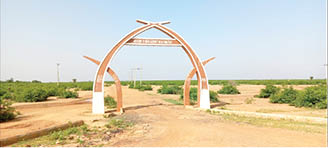CULTURE & TRADITION: The making of a Durbin Katsina
The title of Durbi holds a great significance in the Katsina emirate. The holder of the title is usually one of the king-makers. Although, it is the fourth in hierarchy in the emirate council, after Kaura, Yandaka and Galadima, the present Durbi is closer to the emir than the other king-makers in terms of blood […]

A gate leading to Durbi ta Kussheyi, proposed tourist attraction site
The title of Durbi holds a great significance in the Katsina emirate. The holder of the title is usually one of the king-makers. Although, it is the fourth in hierarchy in the emirate council, after Kaura, Yandaka and Galadima, the present Durbi is closer to the emir than the other king-makers in terms of blood ties, as they are both direct descendants of the renowned Emir Muhammadu Dikko of Katsina.
On the one hand, the present Emir of Katsina, Abdulmumini Kabir Usman is the son of Emir Muhammadu Kabir, the son of Emir Usman Nagogo, the son of Emir Muhammadu Dikko. While on the other hand, the present Durbi, Umaru Babani Isa, is the son of Durbi Isa, the son of Durbi Umaru, the son of Muhammadu Dikko.
Before his ascension to the throne of Emir of Katsina in 1906, Muhammadu Dikko was the Durbi of Katsina. He was the seventh Durbi of Katsina, holding the position from 1894 to 1906.
The title of Durbi, as a district head in Katsina emirate, began in 1806, starting with Durbi Ibrahim, up to the time of Durbi Gidado, the father of Emir Muhammadu Dikko. Hence, the title of Durbi used in other emirates was adopted from Katsina.
However, in 1882, when Dikko was still young, the then Emir of Katsina, Ibrahim died, and Musa, who was not in good terms with Gidado, (Dikko’s father) became emir. He confiscated the family’s properties, stripped Gidado of the Durbi title and gave it to his own son Yero. This caused Dikko hardship, but Musa’s death and the ascension of Ibrahim’s son, Abubakar brought relief. Yero was stripped of the title and Dikko’s older brother, Muhammadu Sada, was appointed. Abubakar also imprisoned Yero, accusing him of the murder of Gidado.
This history repeated itself in 2002, when the emir of Katsina took away the title of Durbi from its original home of Mani to Jikamshi, where he appointed Alhaji Aminu Kabir Nagogo as Durbin Katsina, district head of Jikamshi, while the present Durbi, who was to be turbaned then as Durbi, was given the title of Sarkin Gabas, district head of Mani.
However, in 2019, the emir decided to return the title of Durbi to its original place, a situation that led to the resignation of the Jikamshi district head.
Durbi-ta-Kusheyi
The title of Durbi got its name from Durbi-ta-Kusheyi, which is a town in Mani Local Government Area of Katsina State, just about 32 kilometers from Katsina city. This town is believed to be the earlier settlement of the Katsina kingdom. There are still historical sites and things in the town that confirm the existence of a dynasty or a kingdom.
The town is now more commonly known as Durbi-ta-Kusheyi because of the huge tombs (Kusheyi) like those of giant people who lived in the past. Some historians are of the opinion that six kings ruled in the town before they were moved to Katsina town by Muhammadu Korau. The tombs are so large because, in addition to the perceived large size of the people in those times, in the tradition of the people of the place, when a king died, they buried him with all his belongings.
According to the village head of Durbi ta Kusheyi, Malam Shamsu Yusuf, there are some relics that archaeologists from Germany dug out of some of the graves that confirm this narrative.
“They dug out two graves. One was believed to be that of King Sanau Jikan Tsaga-Rana (the last king of Durbi) because some of the relics found in it belonged to a male gender, including hand-band worn during battles and huge finger rings among others. The other tomb dug is believed to be that of Queen Katsi, from whom the name of Katsina was gotten. This is also because the relics found inside belonged to a female gender.
“However, all these are not conclusive because there are other tombs that were not dug due to the hard materials they were made up. The archaeologist that came said he needed more sophisticated tools to dig them. However, the state government has banned any excavation in the area now, because the relics discovered were taken to Germany and it took a lot of effort from the then Ibrahim Shema administration for them to be returned to the country,” he said.
Among the historical sites that are still in Durbi town is the royal palace which is surrounded by mountains. Inside the palace, there is a baobab tree named, “Kukar Katsi”, meaning “the baobab tree of Katsi”.
“Katsi was the younger sister of Queen Daurama of Daura, and present day Katsina area.
Durbi Umaru Babani Isa
The current Durbin Katsina, Umaru Babani Isa, named after his grandfather, Durbi Umaru, was first turbaned as Magaji Kwatta then Sarkin Gabas (A title once held by his father before he became Durbi) then to the present title of Durbin Katsina and district head of Mani. He was made the Durbi on June 1, 2019.
He is the 13th Durbi of Katsina, taking into account the fact that Durbi Aminu Kabir Nagogo was not part of the Gidado lineage.
Before him were Durbi Aminu (2002-2019) Sanusi Isa (1993 -2002) Isa Maishanu (1965-1993) Ummaru (1939-1965) Muhammadu (1906-1939) Muhammadu Dikko (1894-1906) Sada (1887-1894) Yero (1882-1887) Gidado (1860-1882) Fandigo (!836-1860) Saddiqu (1810-1836) and Ibrahim, who died in 1806.
